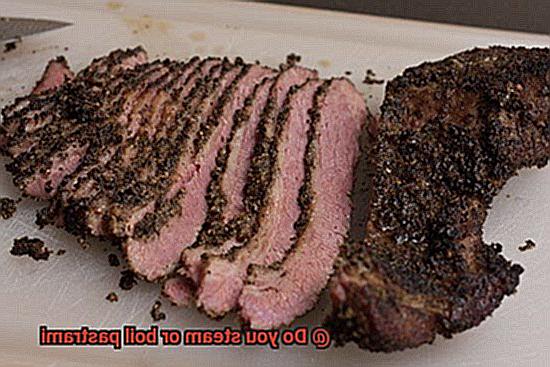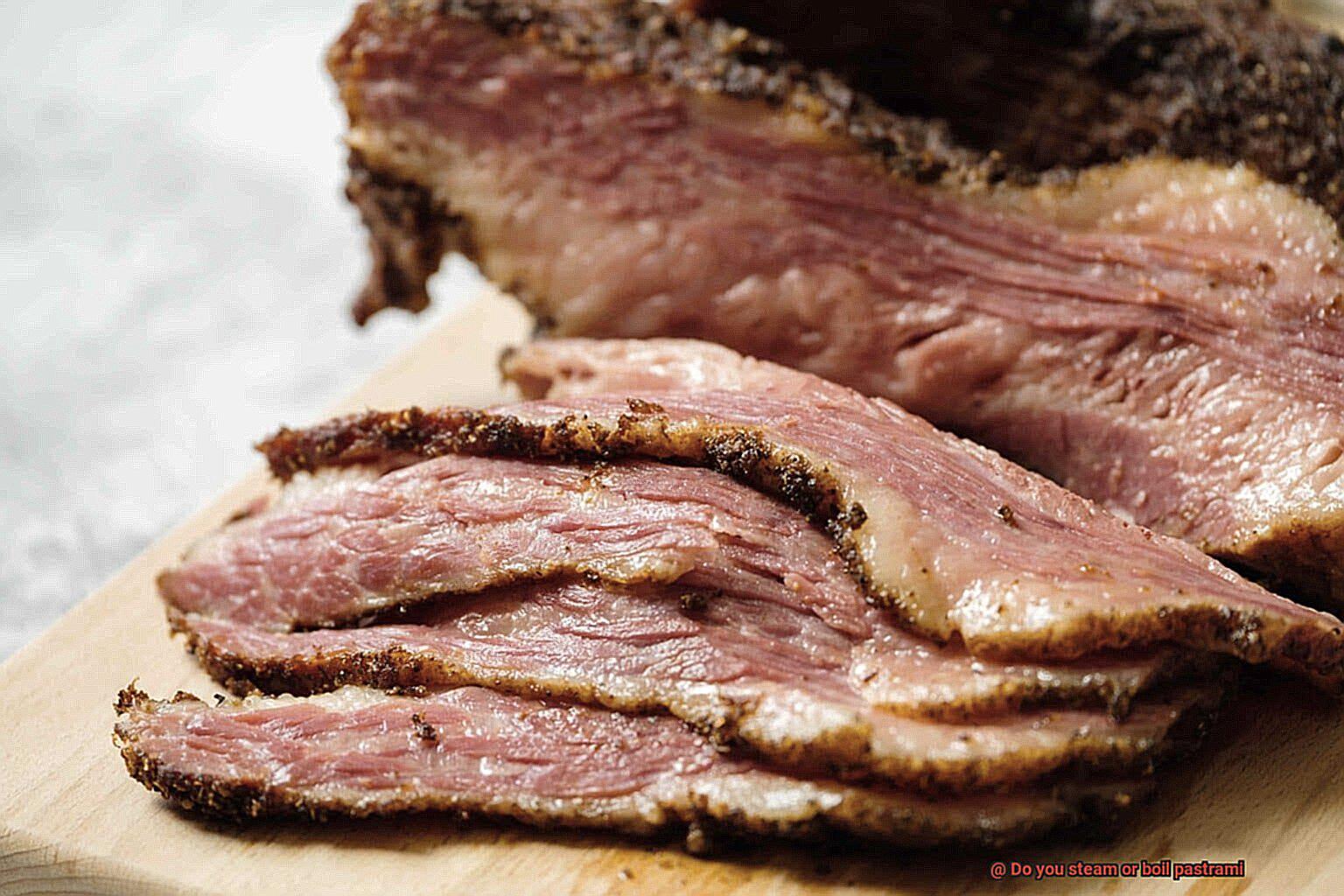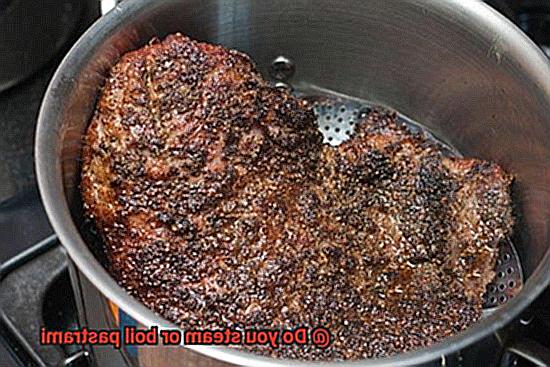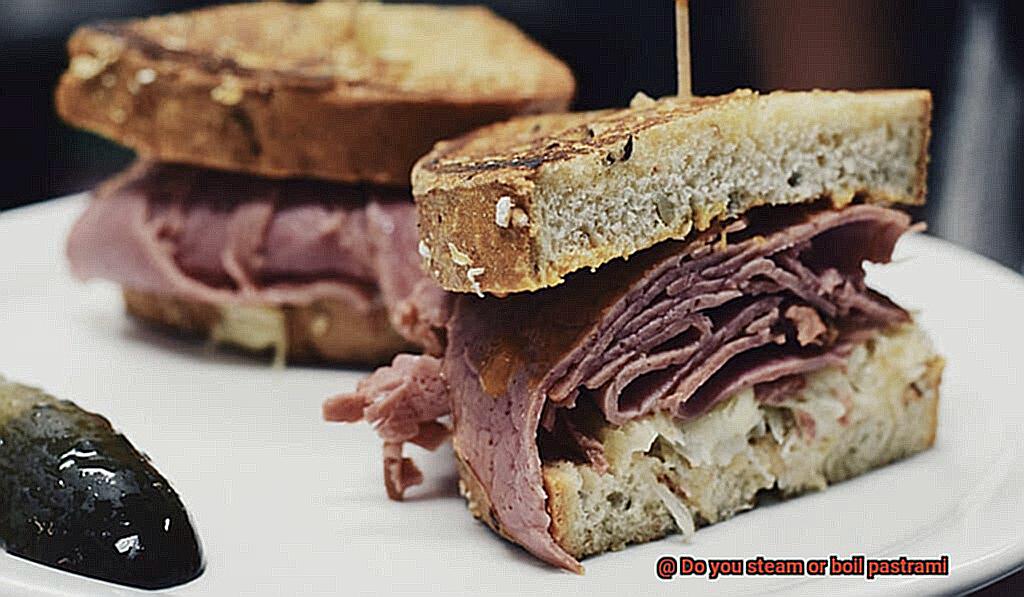Are you a meat sandwich fanatic? Do you crave the mouthwatering taste of pastrami on rye? If so, then you know that how pastrami is prepared can make or break the dish. The age-old question of whether to steam or boil pastrami has been debated for years, with passionate opinions on both sides.
Pastrami originated in Romania and has since become a beloved staple in New York cuisine. This cured beef is seasoned with a blend of herbs and spices before being smoked to perfection. But what sets it apart is the preparation method, which gives it its unique flavor and tenderness.
The debate over steaming versus boiling centers around texture and consistency. Boiling involves cooking the pastrami in water or broth until it’s juicy and tender. Steaming, on the other hand, uses steam to cook the meat, resulting in a moist texture with a slight chewiness. Ultimately, it comes down to personal preference.
In this article, we’ll delve into both methods and their distinct qualities while providing our expert opinion on which one reigns supreme. So sit tight as we settle once and for all whether to steam or boil your next pastrami sandwich.
Contents
What is Pastrami?
Pastrami, a beloved deli meat, has a rich history that dates back centuries. This traditional Jewish delicacy originated in the Ottoman Empire in the Romanian town of Pastrama and has since become a staple in delis and restaurants worldwide.
The process of making pastrami involves several steps, starting with beef from the brisket or navel cut. The beef is soaked in a brine containing water, salt, sugar, curing salt, and spices like coriander, garlic, and black pepper for several days. The brining process enhances the flavor of the meat and helps preserve it.
After brining, the beef is coated with a spice rub and smoked over hardwood for several hours, giving it its signature smoky flavor. Once the smoking process is complete, the beef is either steamed or boiled to make it tender and juicy. Steaming is preferred as it helps retain the moisture and prevents it from drying out.
Pastrami can be enjoyed in countless ways. It can be served as a sandwich with rye bread, mustard, and pickles, or as a topping on pizza or baked potatoes. Some people even enjoy eating pastrami on its own as a snack or appetizer.
When it comes to preparing pastrami, there are different methods to choose from – namely steaming and boiling. While steaming preserves the tenderness and flavor of the meat better than boiling does, boiling is quicker and more convenient. Ultimately, the choice between these two methods comes down to personal preference.
Steaming Pastrami: The Traditional Method
The traditional method of steaming pastrami is sure to satisfy your cravings for tender, juicy, and flavor-packed meat. This cooking process involves a steam bath that works wonders in tenderizing the meat and infusing it with mouth-watering flavors.
To begin, you’ll need a pot or large pan with a lid, a small amount of water, and of course, your delicious pastrami. The key is to ensure the meat is not submerged in water but has enough to create steam. Once you have your ingredients ready, place the pastrami in the pot or pan and add water up to an inch from the sides of the meat.

Cover the pot with a lid and heat it over medium heat until the water begins to boil. Once boiling, reduce the heat to low and let the meat steam for several hours. The cooking time will vary depending on how large your meat is and how well-done you want it to be. A general rule of thumb is to steam the pastrami for about an hour per pound.
One of the best things about steaming pastrami is that it retains its moisture and juiciness. The steam created during cooking traps moisture within the meat, preventing it from drying out. Moreover, any spices or seasonings added to the water will permeate into the meat, giving it a burst of extra flavor.
Boiling Pastrami: A Quicker Alternative
Boiling pastrami offers several advantages over steaming, including faster cooking times and the ability to infuse extra flavor into the meat. To get started, simply place the pastrami in a large pot with water and other ingredients such as garlic, onion, black pepper, and bay leaves. Bring the water to a boil over high heat, then reduce the heat to medium-low and let the pastrami simmer for about 2-3 hours.
The cooking time will depend on the size of the pastrami, but you can test if it’s done by using a meat thermometer to ensure it reads at least 165°F (74°C). Once cooked, remove the pastrami from the pot and let it rest before slicing thinly against the grain.
One major advantage of boiling pastrami is that it allows for greater control over the level of doneness. With steaming, it can be harder to monitor the temperature and ensure that your meat is cooked to your preferred level. Additionally, boiling works well if you need to cook large quantities of pastrami quickly.
However, some people argue that boiling can make the meat less tender than steaming. Additionally, while you can add flavor to your cooking liquid when boiling, some of that flavor may be lost when you drain off the liquid after cooking. Lastly, boiling doesn’t allow for any browning or crisping of the outside of the pastrami.
Pros and Cons of Steaming vs. Boiling Pastrami
We have all the information you need to make an informed decision. As an expert in the field, I can tell you that both steaming and boiling have their own set of pros and cons.
Let’s start with steaming. This method is perfect for those who want to maintain the integrity of their pastrami’s natural flavors and texture. Steaming keeps the meat moist and tender without sacrificing any of its juices, making it a healthier option that doesn’t require additional fats or oils. Plus, the cooking process is much faster than boiling, so you’ll be able to satisfy your cravings in no time.
On the other hand, if you’re looking to add more flavors to your pastrami, then boiling may be the way to go. Boiling allows the meat to absorb additional flavors from water and any added seasonings, resulting in a succulent pastrami that bursts with flavor. However, overcooking can cause the meat to become dry and lead to a loss of some of its natural juices.
To summarize, here are the pros and cons of each method:
Steaming:
- Maintains natural flavors and texture
- Keeps meat moist and tender
- Healthier option
- Faster cooking process
Boiling:
- Adds additional flavors
- Results in a succulent pastrami bursting with flavor
- Risk of overcooking and dryness
- Possibility of losing some natural juices
Ultimately, it all comes down to personal preference. If you prioritize health and speed, then steaming is your best bet. But if you’re willing to take the time and effort to get that extra burst of flavor in your pastrami, then boiling might just be worth it.
Seasoning Your Pastrami: Tips and Tricks
Pastrami is a beloved meat that is known for its rich and savory flavor. However, the secret to making the perfect pastrami lies in the seasoning process. Here are some tips and tricks for seasoning your pastrami just right.
Tip 1: Use a Well-Crafted Dry Rub
The first step in seasoning your pastrami is to use a dry rub. A dry rub is a mix of spices and seasonings that are rubbed onto the meat before cooking. The most common ingredients in a pastrami dry rub include black pepper, coriander seeds, garlic powder, paprika, and brown sugar. Some recipes may also include additional spices such as cinnamon, allspice, or mustard powder.
When applying the dry rub, make sure to coat all sides of the meat evenly with the spice mixture. Don’t be afraid to be generous with your spice rub, as this will ensure that the flavors are fully infused into the meat.

Tip 2: Let It Marinate
Once your pastrami is coated in the dry rub, it’s important to let it marinate for at least 24 hours before cooking. This means wrapping it tightly in plastic wrap and leaving it in the refrigerator. This will give the spices plenty of time to penetrate the meat and create a deep and complex flavor profile. You can even let it marinate for up to three days if you have the time.
Tip 3: Choose Your Cooking Method
There are several different ways to cook pastrami, each with its own unique flavor profile and texture. One popular method is smoking the meat over low heat for several hours until it reaches an internal temperature of 165 degrees Fahrenheit. This method results in tender and flavorful pastrami with a deep smoky flavor.
Another common method is boiling or steaming the pastrami. Boiling is a faster method that can result in a more tender and juicy meat, but it can also cause the meat to lose some of its flavor and texture. Steaming takes longer but can help preserve the flavor and texture of the meat.
Tip 4: Season Evenly
When seasoning your pastrami, make sure to evenly coat all sides of the meat with the spice rub. This will ensure that every bite is bursting with flavor. Additionally, it’s important to note that the amount of seasoning needed may vary depending on the size of the meat being used.
Tip 5: Experiment with Different Spices and Cooking Methods
Don’t be afraid to experiment with different spice blends and cooking methods to find the perfect combination for your taste buds. Whether you prefer a smoky flavor or a classic deli-style pastrami, there is a seasoning and cooking method out there that will suit your preferences.
Popular Dishes to Make with Pastrami
Fear not, because there are plenty of other delicious dishes you can make with this versatile meat. As an expert on popular dishes to make with pastrami, I’ve done my research and compiled a list of some of the tastiest options.
First up, we have the classic pastrami sandwich. This simple yet delicious sandwich is made with sliced pastrami, mustard, and a pickle on rye bread. But don’t be afraid to get creative – try adding some cheese, lettuce, tomato, or onion to make it your own.
If you’re feeling adventurous, try a Reuben sandwich. This variation on the classic pastrami sandwich includes sauerkraut and Russian dressing on grilled rye bread. Swiss cheese is also commonly added for some extra flavor. The combination of tangy sauerkraut and savory pastrami is sure to delight your taste buds.
Looking for a unique twist on pizza night? Try adding sliced pastrami as a topping to your favorite pizza. Pair it with other toppings like mushrooms, onions, or peppers for a flavor explosion in every bite. The smoky flavor of the pastrami pairs perfectly with the rich tomato sauce and gooey cheese.
For breakfast lovers, pastrami hash is a must-try. Combine diced potatoes, onions, and bell peppers with chopped pastrami for a hearty breakfast dish. Serve it with fried eggs for the ultimate morning meal that will keep you full until lunchtime.
Craving some Mexican flavors? Use sliced pastrami as a filling for tacos along with traditional toppings like salsa, lettuce, and cheese. This is a great way to switch up taco night and add some extra flavor to your meal. The salty pastrami pairs well with the spicy salsa and creamy cheese.

Last but not least, we have the pastrami pasta salad. Combine cooked pasta, diced pastrami, cherry tomatoes, cucumber, and Italian dressing for a flavorful pasta salad that’s perfect for potlucks or picnics. The combination of textures and flavors in this dish is sure to impress your guests.
Health Benefits of Eating Pastrami
Yes, that’s right, your favorite cured meat is more than just a flavor-packed ingredient in your sandwich or pizza. Pastrami is a powerhouse of essential nutrients that can boost your overall health and well-being.
Let’s start with the obvious – protein. Pastrami is a rich source of protein, which is critical for building and repairing muscles and tissues in the body. Whether you’re an athlete or just trying to stay fit, incorporating pastrami into your diet can give you the energy and strength you need to power through your day.
But the benefits don’t stop there. Pastrami also contains important vitamins and minerals such as vitamin B12, iron, and zinc. Vitamin B12 helps maintain healthy nerve cells and red blood cells, while iron is necessary for producing hemoglobin, which carries oxygen throughout the body. Zinc is crucial for supporting a robust immune system and aiding in wound healing.
And if you’re worried about fat intake, don’t be. Pastrami contains healthy fats like omega-3 fatty acids that can help improve heart health. These fatty acids have been shown to lower blood pressure, reduce inflammation, and decrease the risk of heart disease.
However, it’s essential to pay attention to sodium levels when consuming pastrami. Due to its curing process with salt and other spices, pastrami can be relatively high in sodium. High sodium intake can lead to high blood pressure and other health issues. To reap the benefits of pastrami without overdoing it on the salt, enjoy it in moderation and balance it out with fresh fruits and vegetables.
Conclusion
In conclusion, the age-old debate over whether to steam or boil pastrami remains unresolved. Both methods have their advantages and disadvantages, leaving the ultimate decision up to personal preference. While steaming preserves the meat’s tenderness and flavor, boiling is a quicker and more convenient option.
Pastrami is a beloved deli meat with a rich history spanning centuries. Originating in Romania, it has become a staple in delis and restaurants worldwide. The process of making pastrami involves soaking beef in a brine containing water, salt, sugar, curing salt, and spices before smoking it over hardwood for several hours.
To create the perfect pastrami flavor profile, using a well-crafted dry rub with black pepper, coriander seeds, garlic powder, paprika, and brown sugar is essential. Letting the meat marinate for at least 24 hours before cooking allows the spices to penetrate deeply into the meat.
Beyond sandwiches, there are countless delicious dishes you can make with this versatile meat. From breakfast hash to pizza toppings, pastrami adds depth of flavor to any dish.
While pastrami contains essential nutrients like protein and vitamins B12 and zinc as well as healthy fats like omega-3 fatty acids that improve heart health, it’s important to consume it in moderation due to its high sodium levels from its curing process with salt and other spices.
In summary, whether you prefer steaming or boiling your pastrami is entirely up to you.






